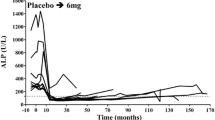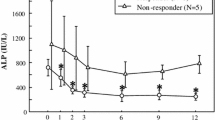Abstract.
Zoledronate (CGP 42446) is a third generation imidazole ring containing bisphosphonate that has been found in animal studies to be up to 850 times more potent than pamidronate. In this first study reporting the effects of this drug in humans, 16 patients with active Paget's disease of bone [baseline serum alkaline phosphatase activity (SAP) at least twice the upper limit of normal] were treated in a fixed ascending dose-ranging protocol with a single 1-hour infusion of either 24, 72, 216, or 400 μg of zoledronate (four patients per dose). SAP and two markers of bone resorption, 24-hour urinary hydroxyproline/creatinine excretion (OHP) and 24-hour urinary calcium/creatinine excretion, were measured at baseline, 24 hours postinfusion (day 1) and on postinfusion days 3, 7, 10, and 14. Safety parameters including vital signs, hemogram, and chemistries were measured at the same time points. At the 24- and 72-μg doses there were no consistent or meaningful changes in the bone resorption markers. However, with the 216 μg dose, urinary OHP decreased from baseline by a mean of 16–19% on days 3, 7, 10, and 14; with the 400 μg dose, OHP decreased by a mean of 33–48% at days 1, 7, and 10 and by 16% at day 14. Urinary calcium/creatinine decreased from baseline with the 216 μg dose by a mean of 15–40% on days 1, 3, 7, 10, and 14 and with the 400 μg dose by a mean of 55–71% on days 3, 7, 10, and 14. As expected, there was no reduction in SAP during the 14-day postinfusion period. There was no evidence of an acute phase reaction (pyrexia, myalgia, or arthralgia), leukopenia, or renal or hepatic toxicity. We conclude that single infusions of microgram amounts of zoledronate were capable of inhibiting bone resorption in patients with active Paget's disease during a 2-week study interval. This anti-bone resorbing effect was not associated with any clinically or biochemically observed toxicity. This potent new bisphosphonate appears to be a promising compound for the management of skeletal disorders characterized by increased bone resorption.
Similar content being viewed by others
Author information
Authors and Affiliations
Additional information
Received: 26 February 1996 / Accepted: 15 October 1996
Rights and permissions
About this article
Cite this article
Arden-Cordone, M., Siris, E., Lyles, K. et al. Antiresorptive Effect of a Single Infusion of Microgram Quantities of Zoledronate in Paget's Disease of Bone. Calcif Tissue Int 60, 415–418 (1997). https://doi.org/10.1007/s002239900255
Published:
Issue Date:
DOI: https://doi.org/10.1007/s002239900255




